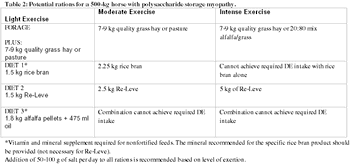Anna Firshman, BVSc, PhD, CERP, DACVIM
Articles by Anna Firshman, BVSc, PhD, CERP, DACVIM

The use of underwater treadmill exercise for training and rehabilitation of horses has become increasingly popular in recent years. Many claims are made as to the usefulness of this form of exercise in horses; although relatively little published information is available to substantiate these assertions. In humans, underwater treadmill therapy has long been recognized for benefits in rehabilitation.

Characterized by clinical and laboratory findings of muscle damage not associated with exercise. Includes inflammatory, nutritional, toxic, traumatic, metabolic, congenital, immune mediated and idiopathic causes of muscle disease.

Evaluation of the muscular system includes inspection for symmetry of muscle mass while standing square. Prior to palpation evidence of fine tremors or fasciculations should be noted. Palpate entire muscle mass for heat, pain, swelling or atrophy comparing contra lateral muscle groups.

Muscle atrophy refers to a decrease in muscle size, particularly in muscle fiber diameter. Atrophy can reflect a disorder of the muscle cells (myogenic atrophy) or loss of neural stimulation to the muscle cells (neurogenic atrophy). Trauma, infection and nervous disorders are all causes of atrophy in horses.

Exertional rhabdomyolysis is muscle necrosis precipitated by exercise or exertion, resulting in myoglobinuria, elevated serum CK (usually > 5,000 in acute cases) and/or elevated AST in animals with normal liver function.

The coordinated actions of the cardiovascular and respiratory systems result in the transport of oxygen and energy products (glucose, fatty acids) to the muscle fibers, where they are used for aerobic energy production, and the removal of waste products (lactate, carbon dioxide, water) from them.


